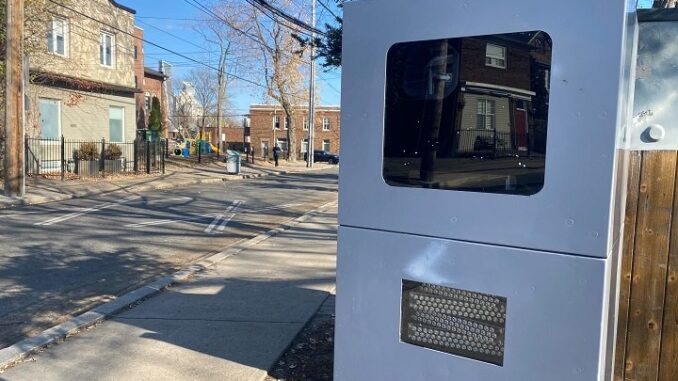
Three years after the start of issuing tickets to speeding vehicles, evaluation data from the City of Toronto’s Automated Speed Enforcement (ASE) program highlight how speed cameras have been effective in significantly reducing the number of people speeding and overall vehicle speeds, pointing to increased compliance and improved driver behaviour.
An evaluation study conducted by researchers from The Hospital for Sick Children (SickKids) in collaboration with the Toronto Metropolitan University (TMU) analyzed speed and collision data from January 2020 to December 2022 at 204 locations that had an ASE device. Although data collection was affected by the pandemic, substantial data was collected during periods without stay-at-home orders or school closures.
The study shows that the proportion of people speeding in 30, 40 and 50 km/h speed limit zones dropped from approximately 60 to 43, 51 to 30 and 58 to 36 per cent respectively when the devices were operational. This represents an overall 45 per cent reduction in the proportion of people speeding in areas with an ASE device.
The data also show the introduction of ASE devices reduced the operating speed of vehicles or the speed at which most vehicles travel in free-flowing conditions, helping to mitigate the potential risks associated with high-speed traffic. Vehicle operating speeds in 30, 40 and 50 km/h speed limit zones dropped from approximately 44 to 37, 50 to 44 and 63 to 60 km/h respectively when the devices were active. This represents an overall decrease of approximately seven km/h in vehicle operating speeds in areas with an ASE device.
The study also found the percentage of drivers exceeding the speed limit decreased at 80 per cent of locations with an ASE device. Excessive speeding – driving over the speed limit by 20 km/h or more – was also reduced by 87 per cent after the placement of an ASE device.
The full evaluation report is available by visiting www.toronto.ca/ASE.
The City’s Automated Speed Enforcement program began operation in July 2020. Currently, there are 75 devices issuing tickets to speeding vehicles. The program aims to increase road safety, reduce speeding and raise public awareness about the need to slow down and obey posted speed limits. It is designed to work with other Vision Zero actions, including engineering measures, education initiatives and traditional police enforcement.
The total payable fine includes a set fine determined by Schedule D under the Provincial Offences Act, a victim fine surcharge and applicable court costs. ASE tickets do not incur any demerit points and do not affect a person’s driving record.
All ASE devices are installed in Community Safety Zones. Sites are selected primarily based on data that indicate where speed and collision challenges exist. Each municipal ward has three ASE devices that capture and record images of vehicles travelling in excess of the posted speed limit.
More information about the program, how to pay fees and a map of all current and planned locations are available at toronto.ca/ASE.
The World Health Organization (WHO) has identified speed to be a key contributing factor in all road traffic collisions, deaths and injury severity. High speeds reduce driver reaction time, increase the vehicle stopping distance and inflict more severe blunt force trauma on victims upon impact. The risk of fatal collisions rises by 4-5 per cent for every 1 km/h increase in vehicle speeds.
Through the Vision Zero Road Safety Plan, the City developed a Speed Management Strategy comprised of seven integrated speed reduction tools aimed at mitigating risks associated with high speeds. These include revised speed limit setting practices, road design improvements, enhanced police enforcement, proactive deployment of ‘Watch Your Speed’ signs, speed limit reductions, automated enforcement and public education.
Quotes:
“The results of this study highlight the remarkable impact of Automated Speed Enforcement. It’s gratifying to see that 80 per cent of the locations with an Automated Speed Enforcement device witnessed a decline in the percentage of drivers exceeding the speed limit. This is a testament to the program’s effectiveness in slowing down drivers and creating a safer environment for our school communities. These findings, coupled with the other Vision Zero measures the City continues to implement, reaffirm our dedication to implementing evidence-based strategies for road safety.”
– Deputy Mayor Jennifer McKelvie (Scarborough-Rouge Park), Chair of the Infrastructure and Environment Committee
“I am very pleased to see the substantial reductions in motor vehicle speeds in school zones as a direct result of the City’s Automated Speed Enforcement program. Active commuting has tremendous individual health and social benefits, and children and youth should have the ability to walk or cycle in a safe environment to set these habits early in life. News of severe and fatal child pedestrian injuries is all too common in Toronto. All childhood traffic injuries are preventable, and vehicle speed reduction is a cornerstone of prevention. Automated Speed Enforcement is a tool that Toronto can use, alongside other strategies, to realize the vision of a city with zero deaths or severe injuries from road traffic.”
– Dr. Andrew Howard, Head, Division of Orthopaedic Surgery and Senior Scientist, Child Health Evaluative Sciences, The Hospital for Sick Children (SickKids)
SOURCE City of Toronto

Leave a Reply